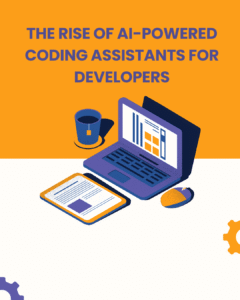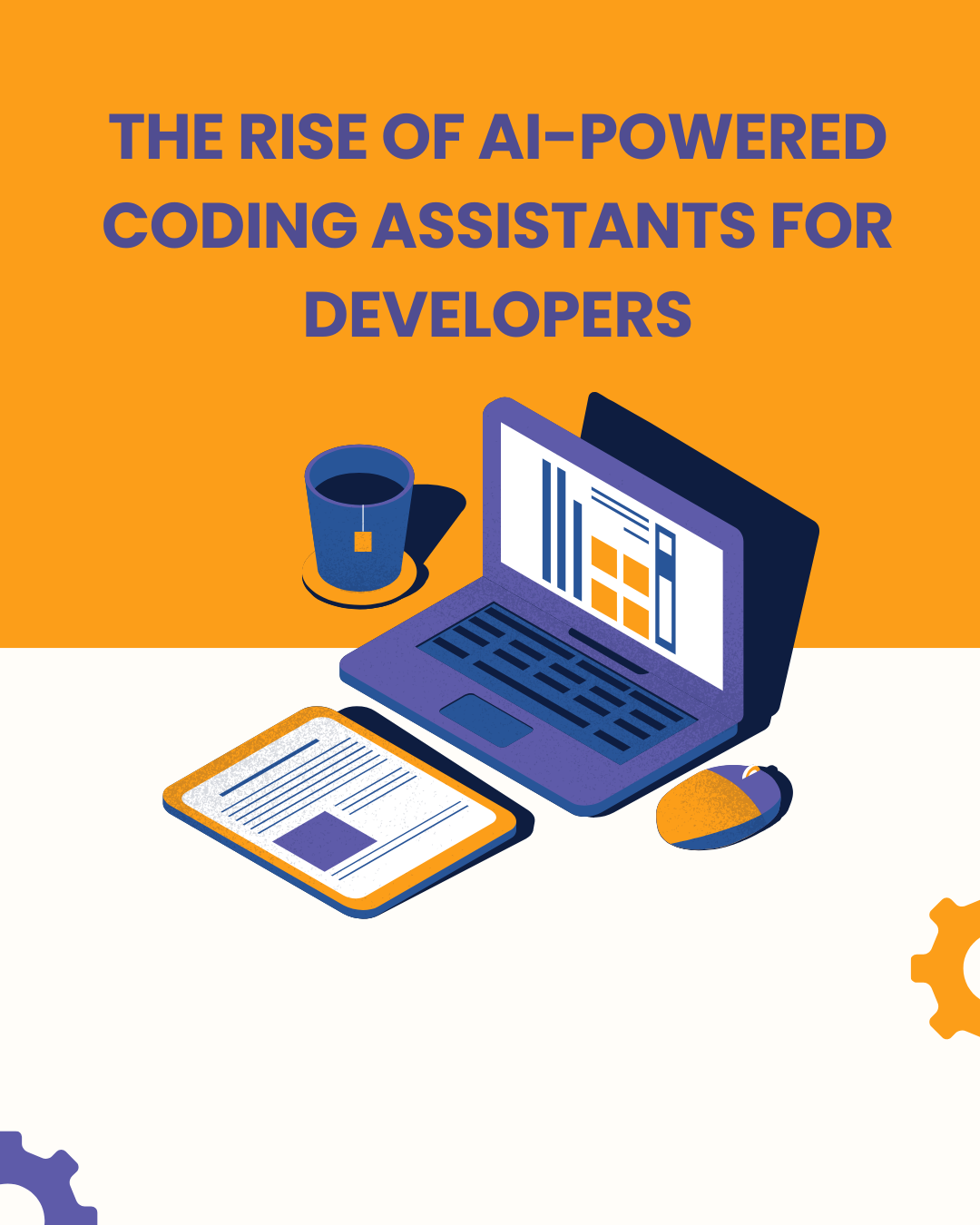The Rise of AI-Powered Coding Assistants for Developers
Introduction:
A New Era of Coding
Software developers have depended on intuition, experience, and documentation to create the digital world for decades. From assembly code scribbled by hand in the 1950s to the cloud-native frameworks of the 2020s, programming has always changed — but never as fast as it is now. The last few years have brought a new, nearly revolutionary collaborator to developers: AI coding assistants.
Products such as GitHub Copilot, Chat GPT , Amazon Code Whisperer, Tab nine, and Replot Ghostwriter are transforming code authoring, review, and optimization. These tools don’t merely autocomplete code snippets — they know context, infer developer intent, and even provide explanations of bugs or generate documentation.
What was once science fiction — a computer that assists you in coding — is now a part of everyday life in most development environments.
In this post, we’ll explore how AI-powered coding assistants have risen to prominence, how they work, what benefits and challenges they bring, and where the future of AI-driven development might be headed.
1. The Origins of AI Coding Assistants
The concept of AI assisting humans in coding is not a new one. The first attempts were made in the 1980s, when experts began playing around with expert systems that can create trivial programs or verify correct code. These early systems, though, were hampered by computer strength and didn’t have real “knowledge” of language or logic.
Fast forward to the 2010s, and a new wave of machine learning models began to change the landscape. Natural Language Processing (NLP) — the ability for computers to understand and generate human language — evolved drastically with the introduction of transformer models like Google’s BERT and Open AI’s GPT series.
By the year 2020, when Open AI introduced Codex, the engine behind GitHub Copilot, developers could finally see something remarkable: AI that could accept a natural language request such as “write a function that sorts a list of students by grade” and produce working, syntactically valid code.
This was the time when AI coding assistants ceased being a theoretical aspiration and began becoming an industry norm.
2. How AI Coding Assistants Actually Work
AI coding helpers are constructed on large language models (LLMs) — deep learning models learned from huge quantities of text, such as open-source repositories of code, documentation, programming texts, and web fora.
Here is a quick explanation of how they work:
Training on Huge Amounts of Data:
These models are learned on billions of lines of code in a variety of programming languages. They do not just learn about syntax, but also style, patterns, and typical solutions.
Contextual Understanding:
Advanced AI assistants are able to “read” your immediate file, project context, and even documentation in order to anticipate what you will want to do next.
Natural Language Prompts:
The developers can simply enter plain English prompts such as:
“Write a function to compute the Fibonacci sequence.”
The AI creates applicable code — sometimes along with comments and test cases.
Feedback and Refinement
Many assistants improve over time through user feedback, telemetry data, and reinforcement learning — making their suggestions increasingly accurate.
The result is a collaborative experience: developers focus on problem-solving and creativity, while AI handles boilerplate, repetitive, or syntax-heavy tasks.
3. The Key Players in the AI Coding Revolution
Let’s look at some of the biggest names shaping this new ecosystem:
1. GitHub Copilot
Powered by Open AI’s Codex, GitHub Copilot was one of the first mainstream AI assistants for developers. It integrates seamlessly with editors like VS Code, offering real-time suggestions and code completion. Copilot can understand entire files, suggest tests, and even explain code.
2. Chat GPT (Open AI)
Although Chat GPT is not a coding IDE plugin by default, it has become a necessary tool for developers. From refactoring and debugging to describing intricate algorithms, it serves as an “AI mentor.” Developers now widely use Chat GPT in conjunction with their IDE to ideate solutions or discover new frameworks.
3. Amazon Code Whisperer
Developed by AWS, Code Whisperer assists developers in coding for the best performance in Amazon’s cloud platform. It prioritizes security, proposing secure coding patterns and vulnerability scanning.
4. Tab nine
Tab nine employs smaller, privacy-oriented models trained on permissively licensed code. It supports numerous editors and is used by groups that prefer AI help without compromising code privacy.
5. Replit Ghostwriter
Targeted at students and independent developers, Replit Ghostwriter provides in-browser AI support. It’s ideal for quick prototyping and has support for multiple languages and frameworks.
All of these tools play a part in the increasing trend of how developers approach coding — from typing out every line by hand to working with AI.
4. Why Developers Are Adopting AI Assistants
The speed at which developers are adopting AI-driven coding tools is not hype — it’s based on real advantages:
a. Speed and Efficiency
AI assistants cut development time dramatically by producing boilerplate code, syntax handling, and function suggestions in an instant. What took hours before — e.g., setting up APIs or creating tests — can now be completed within minutes.
b. Learning and Upskilling
Developers can learn quicker by observing examples that AI has created. It is like having an on-demand coding tutor which clarifies concepts, syntax, and best practices.
c. Fewer Errors
AI models can mark bugs, propose patches, and even detect security flaws. Most assistants leverage static analysis and best practices from big codebases to propose solid patterns.
d. More Emphasis on Creativity
Automating the drudgery of coding makes it possible for developers to concentrate on architecture, design, and problem-solving — the aspects of software engineering that really need human wisdom.
e. Improved Collaboration
AI tools are able to enforce quality code everywhere, automatically comment functions, and provide style recommendations — resulting in neater, easier-to-maintain projects.

5. Real-World Examples: AI in Action
- AI assistants aren’t mere gimmicks — they’re delivering real productivity improvements in industries.
- Startups leverage them to build MVPs quicker. A single developer is now able to create what it took a whole team to do before.
- Businesses are incorporating AI into CI/CD pipelines for automatic documentation, code review, and test creation.
- Educational platforms are using AI to assist students with debugging code and learning logic without human assistance.
- Open-source projects are applying Copilot and ChatGPT to keep repositories up to date, tidy up code, and automate commits.
For example, Meta and Google developers have internal Copilot-like AI systems that read millions of lines of internal code in order to predict what’s coming next. Eventually, such systems could make mass software development self-optimizing.
6. Challenges and Controversies
Despite the buzz, AI coding assistants do pose genuine challenges — both technical and ethical.
a. Code Quality and Accuracy
AI is not flawless. It may produce wrong or suboptimal code. Programmers still have to scrutinize outputs for correctness and efficiency.
b. Security and Data Privacy
Certain assistants are trained on public code, and such code can contain insecure patterns or licensed code. This would be a problem of intellectual property and data leaks.
c. Overreliance on AI
There is increasing concern that new developers will use AI too heavily, bypassing the learning process of how code operates. This may lead to a generation of “prompt engineers” rather than competent developers.
d. Licensing and Copyright
If an AI model developed using open-source code creates similar patterns, who is the owner of that output? The answer remains legally uncertain in most jurisdictions.
e. Bias in AI Models
AI systems can inherit biases based on the data they were trained on. If there is biased or toxic code patterns in the dataset, then the model may replicate them.
These issues don’t make AI assistants bad — they just point to the importance of responsible use, openness, and ongoing human supervision.
7. The Human-AI Partnership: A New Paradigm
AI is not replacing coders — it’s complementing them. Imagine this: back in the early 2000s, IDEs started implementing autocomplete and syntax highlighting. AI assistants today are the next natural progression — intelligent, chat-like, and context-sensitive.
Top future coders will be those who understand how to collaborate with AI. Rather than being intimidated by automation, they’ll leverage it to scale their productivity.
Indeed, a 2024 study by GitHub discovered that developers who employed Copilot were 55% quicker to complete coding tasks than developers who did not. But speed aside, users found they were more satisfied and less burned out — because they spent fewer hours on routine tasks and more on creative work.
8. The Future of AI-Powered Development
The rise of AI coding assistants is just the beginning. In the next decade, we can expect even more advanced systems:
Fully Integrated AI Dev Environments
IDEs like VS Code or Jet Brains may soon come with native AI agents capable of planning entire projects — from architecture design to deployment scripts.
Self-Healing Codebases
AI could automatically detect outdated dependencies, patch vulnerabilities, and optimize performance in real time.
Autonomous Development Agents
Consider an AI that not only writes code but also executes simulations, tests assumptions, and pushes changes independently once approved.
Voice-Driven Coding
Natural language interfaces will bring programming to non-coders:
“Hey AI, create a web dashboard for my sales data using React and Tailwind.”
And it just does.
AI-Powered Team Collaboration
Systems will manage tasks, create documentation, and even execute pull requests — an invisible project manager.
The line between “developer” and “AI collaborator” will increasingly disappear.
9. Ethical and Professional Implications
As AI gains more power, developers and companies need to consider ethics and accountability.
Transparency: Groups ought to make public when they use AI-created code, particularly in significant or open-source projects.
Attribution: When AI copies a known snippet of code, credit ought to still be provided where appropriate.
Security: AI-created code needs to be tested for security issues prior to deployment.
Job Impact: While productivity increases with AI, businesses need to leverage it to augment human capabilities rather than replace them.
Education Reform: Coding education needs to evolve, with more emphasis on design thinking, debugging, and AI literacy.
These steps ensure that everyone gets to benefit from the AI revolution — not merely the people who own the technology.
10. The Developer’s Perspective: A Shift in Identity
Ask any veteran coder, and they’ll assure you coding has never had much to do with typist fingers but rather with problem-solving and logic. AI helpers underscore that reality. Developers in the future will write less code and more design systems, set objectives, and facilitate AI.
The “art” of coding will become something else — a conversation between human imagination and machine brain.
Conclusion:
The Future Is for Human + AI Collaboration
The advent of coding assistants powered by AI represents one of the largest changes in software development history. Just like a compiler once converted human-readable code into machine-executable code, AI now interprets human intention into functional software.
Developers who master these tools won’t be replaced — they’ll be super-developers, building faster, smarter, and more creatively than ever before.
AI won’t steal coding — it will redefine it.
The future coder isn’t a person who codes line by line — it’s a person who speaks ideas, conducts algorithms, and co-designs with smart systems.
Welcome to the new age of software development — where people and computers construct the future, hand in hand.
